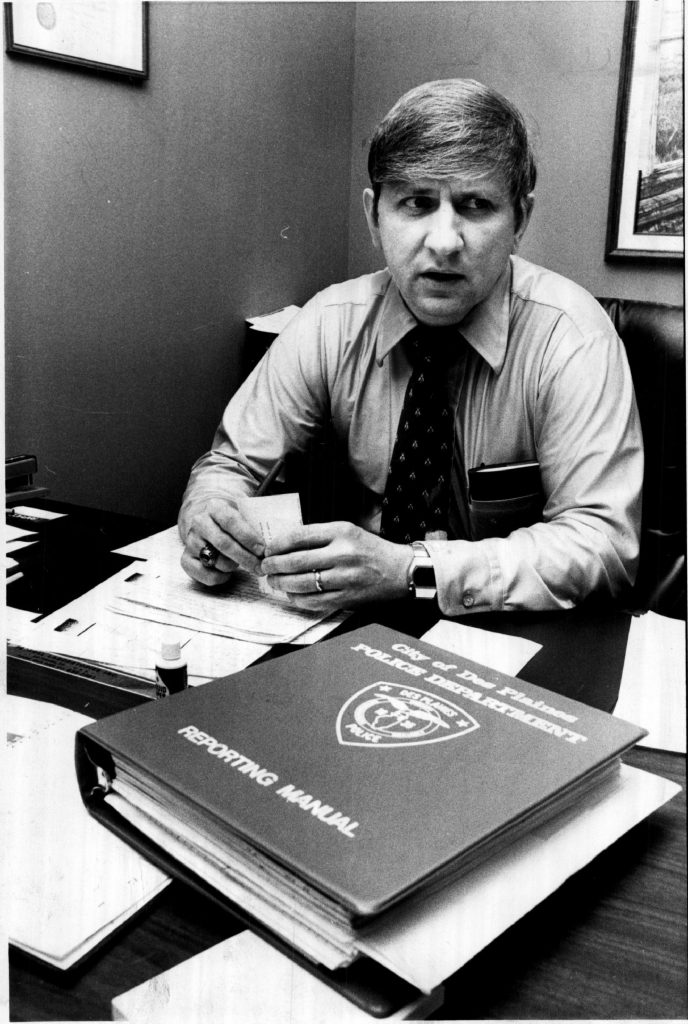Winner of the Fall 2017 StMU History Media Award for
Article with the Best Introduction
It was December 12, 1978. Just as every morning, Chief Detective Joseph Kozenczak sat in his office on the first floor and went over the reports from the past 24 hours. Sipping some coffee, he started off by reading through Monday’s list of events: “a domestic argument which ended with the police restoring peace, a break-in on Phoenix Drive, a report of an abandoned vehicle, several malfunctioning alarms in businesses requiring police assistance to restore, etc.”1 It wasn’t until midway through the list of Monday’s Report when Joseph Kozenczak came across the name Robert Jerome Piest, a missing persons report filed by his mother Elizabeth Piest.2

Joseph Kozenczak had found this to be very interesting because of the narrative part of the report. As described from the report, the mother and son had a very repetitive routine. Elizabeth would pick up her son at 5:30 p.m. after his gymnastics session at Maine West High School in Des Plaines, Illinois. Then she would have his dinner and milk to eat in the car, and he’d usually eat it as Elizabeth drove to Nisson Pharmacy, where Robert worked. But Monday was a bit different. Rob ate a sandwich. Elizabeth had saved her birthday cake to be cut after picking up Rob from work. She arrived at Nisson Pharmacy at 9 p.m., and she went in to get Rob. Rob asked his mother to wait outside so he could discuss a summer job with a construction contractor. Twenty minutes passed and Elizabeth went to check the parking lot only to find that she was alone. There was no sign of Rob, or this mysterious construction contractor. Not knowing who the contractor was, Elizabeth called her son’s friends and one of the owners of the pharmacy, and found out that his name was John Wayne Gacy, Jr.3
Something about the report didn’t seem right to Detective Kozenczak. He knew Robert had no reason to leave his family, or run away from home, so where was he? He read the report one more time. While reading through the report, Detective Kozenczak found that the young boy Robert was born the same year as his own son, as well as the fact that the two boys attended the same high school (Maine West High School).
Detective Kozenczak decided to put “Ronnie” Ron Adams to investigate the Piest missing persons case. He chose Adams because he wasn’t just a good cop, but he also had passion for his job. He knew Adams was the right one for this case. Also Kozenczak knew about the fact that Adams had a family, and had hoped it would make things more personal while continuing the harsh investigation. Adams didn’t waste any time at all. He talked with the two brothers who owned the pharmacy, and found out that the contractor, John Gacy, had been in the store not once, but twice. To check Gacy’s alibi, Adams then called Gacy at 9:15 a.m. and Gacy explained that he had been present at the pharmacy, but only because of some remodeling plans, and to gather or see if there were any tools he needed. He also said, “He had not spoken, nor had any personal contact with the missing boy.” It was at this point that things started to not add up in the mind of Detective Kozenczak.4

The investigation “wasn’t getting anywhere fast” as Kozenczak put it. It was not until Detective Jim Pickell stepped out of his office, when things started to take off. The two detectives knew about Gacy’s arrest, but did not know exactly what John Wayne Gacy had been arrested for. Pickell went off in search of what Gacy had been arrested for. Pickell was known to get what he wanted, and always did what he had to in order to obtain it.
The two Detectives then read Gacy’s rap sheet, which was filled with numerous crimes, the first and most important: “20 May 1968-Waterloo, Iowa-Sodomy-10 years.” The word “sodomy” stuck into the two detectives’ heads. After going through the rap sheet, the two detectives were both convinced Gacy was deeply involved in the disappearance of Robert Piest.5 Later that day,Detectives Kozenczak, Pickell, Olsen, and Sommerschield went to Gacy’s house to interview him. Kozenczak and Pickell went inside, while Sommerschield and Olsen waited outside on the street. While inside the house, Gacy sat in his recliner, and not much happened except for the same story he gave Adams over the phone. Kozenczak had coaxed Gacy into coming down to the station, and after a few attempts, it finally worked.
Gacy called and came in around noon. He had no problem telling the same story, as well as filling out the witness report; but he did seem agitated after he refused a lie detector test. While that was going on, Kozenczak was gathering his warrant, and on his way back to get Gacy’s keys. At 5 p.m. Kozenczak rushed in to find Gacy and asked for his keys. Gacy was terrified and filled with anger. He fought and argued before he was forced to give up his keys.
As Kozenczak put it, “I put the key in the door and I felt like I was stepping into the unknown.”6 They searched the house and found a crawl space that was creepy, but nothing seriously incriminating; but they did take many things as evidence. They took clothes, papers, towels, shoes, etc. It was not until the third warrant was issued that Detective Kozenczak decided to crawl into the crawl space. That’s when everything changed in the blink of an eye.
When Detective Kozenczak crawled into the muddy crawl space, he was face to face with not one or two, but three bodies. He encountered the three bodies in the first ten minutes he had spent in the crawl space. A call was made, and as soon as the news was told to Gacy about the findings, he admitted to the murders with no hesitation. Once the crime scene was investigated and dug up, and everything was done, the Medical Examiner was called in, and over the course of a few weeks or so, twenty-four more bodies were discovered in the ground beneath Gacy’s crawl space. As reported by Detective Kozenczak, “There was plastic over their heads and most of them were partially clothed. They had been strangled and were in various stages of decomposition. There were skeletons everywhere.”7 But that wasn’t the end of finding bodies. The serial killer admitted that there was not enough room left for his last six victims. With no room left for the bodies, Gacy had turned to the river, dumping his last victim Robert Piest into the Des Plaines river. The river was near the Chicago Airport. Gacy admited to dumping the body in the winter of 1978, although they found his body in late spring of 1979. Robert’s body had froze, and was conserved in ice until it thawed out late spring.

Justice was finally served when Gacy was arrested and found guilty after a long and devastating trial in March 13, 1980. He received multiple sentences. “The jury quickly returned a verdict of guilty on thirty-three counts of murder, twelve carrying a death sentence, and two charges of sexual assault.” The jury did the right thing by putting a heartless monster like Gacy away. Gacy was executed by lethal injection on May 10, 1994, in the Stateville Correctional Center in Joliet, Illinois. Gacy was pronounced dead at 12:58 a.m.8
The ending somehow did not seem to lift the weight off the shoulders of Detective Joseph R. Kozenczak, as he stated “I thought that I would feel that it was all resolved then. But it wasn’t. It was just hard to live with.”9 Someone will never understand what it was like to be in the chase, but we know how hard and personal it was for Detective Joseph R. Kozenczak. After the chase was done and finally put to rest, Kozenczak retired and went on to write his own book, A Chicago Killer, which was a great insight into what the Gacy Case was like. Unfortunately Joseph R. Kozenczak passed away Wednesday May 13, 2015. He had served on the Des Plaines Police team as Chief Detective for 27 years.10 Detective Joseph R. Kozenczak’s passion, strength, and patience will live on longer than we can imagine. He brought justice to 33+ families and their relatives.
- Joseph R. Kozenczak and Karen M. Kozencz, The Chicago Killer: The Hunt For John Wayne Gacy (Xlibris, Corp., 2011), 23. ↵
- Joseph R. Kozenczak and Karen M. Kozencz, The Chicago Killer: The Hunt For John Wayne Gacy (Xlibris, Corp., 2011), 24. ↵
- Joseph R. Kozenczak and Karen M. Kozencz, The Chicago Killer: The Hunt For John Wayne Gacy (Xlibris, Corp., 2011), 25. ↵
- Joseph R. Kozenczak and Karen M. Kozencz, The Chicago Killer: The Hunt For John Wayne Gacy (Xlibris, Corp., 2011), 28. ↵
- Joseph R. Kozenczak and Karen M. Kozencz, The Chicago Killer: The Hunt For John Wayne Gacy (Xlibris, Corp., 2011), 37. ↵
- Joseph R. Kozenczak and Karen M. Kozencz, The Chicago Killer: The Hunt For John Wayne Gacy (Xlibris, Corp., 2011), 58. ↵
- Ginnie Teo, “Sleuth Recalls Viciousness of Killer,” The Straits Times (Singapore, August 1997). ↵
- Debbie Howlett and Sandra Sanchez, “John Wayne Gacy Executed/ Fatal Injection Ends Saga Of Serial Killer,” USA Today, (May 1994): 3. ↵
- Ginnie Teo, “Sleuth Recalls Viciousness of Killer,” The Straits Times (Singapore, August 1997). ↵
- N. Sameer Yacoub, “Detective who led John Wayne Gacy Investigation Dies,” US News Online, May 15, 2015. ↵



117 comments
Troy Leonard
Great article! I am so surprised that John Gacy killed over 30 people. you had to have been a really off person to be able to pull that off. I don’t understand what kind of person and commit that many murders and lie so easily about it. if it was not for them cracking this case there is no telling how long or how many people would have become a victim and lost their life
Clarissa Bustamante
This was such an amazing story with a very great introduction. I never really knew about this story and it really surprises me how many people Gacy had killed. It is crazy how the trail took such a long time especially when he had killed liked maybe more than 30 people already. It would have been reasonable that he was guilty and should have been sent away immediately. Overall this article was amazing with awesome detail within it.
Sebastian Castro Ramos
After reading multiple articles about serial killers, I see how people show great interest for them. I wonder what was the reason behind Gacy’s murders, and how he managed to murder so many people without anybody becoming suspicious about him. Because I guess at some point somebody might have seen him taking some victim into his house or heard somebody screaming, or anything else of that sort.
Angela Rodriguez
Growing up, watching these shows about serial killers and murder mysteries, I am glad they caught and were able to connect John Wayne Gacy to the missing person report as well as to the other twenty-four unsolved murders. I know the families of the victims must have been relieved knowing the Gacy will never be able to harm another soul again. This article was great in the way, the author was able to hook their audience from the beginning and continue to keep us at the edge of our seats.
Deanna Lummus
Never heard this story before. Serial killers have always interested me though. This was very informative. I find it so chilling that thee cops had gone to his house once before and had no idea that he had a crawl space where he stored as many bodies as he could. It seems as though the killer had no regard for human life. He didn’t seem ashamed at all and that is the scariest part of it all.
Edward Cerna
This was a really amazing article. It amazes me how many people he killed, it is just crazy and it is hard for me to wrap my head around. It is weird why the trial took so long even though he killed a bunch of people, it really should have just been real quick. I was just drawn to this article and wanted to read it.
Manuel Aguilera
I feel that the detectives are the unsung heroes of our country, they have to endure the pressures of both the victim’s family and the duty of his job, as well as their own internal desire to set things right. I am also slightly confused exactly who the killer is, I see a picture of a clown, I am aware that he is a killer, but in the article I did not grasp when he killed using that costume. Also, I am surprised he was able to accumulate so many bodies of his victims yet not get caught until much later.
Erik Shannon
This is a very interesting article. I have previously heard of John Wayne Gacy before reading this article. This article did a very good job on giving vivid details. The article did a good job at giving us the story in sequential order. The author also did a good job at keeping the reader interested in the article. I did not know that he killed such a large amount of people.
Brianda Gomez
This was such a well-written article! Before reading this article, I did not know that Gacy was a contractor. Rob was just one of many boys whose life was taken by the hands of the notorious serial killer John Wayne Gacy. It truly is heartbreaking to learn that he caused the death of more than 33 young boys. Justice was given to the family of many f the young boys when Gacy was killed by lethal injection in 1994.
Megan Barnett
This story was absolutely unbelievable. It sounded like something you would watch on a crime show. I am still curious though on why Gacy was wearing a clown costume in the picture you included. I also had to reread a few parts because there was so many names and people involved that it was hard to keep up with who was being referred to.